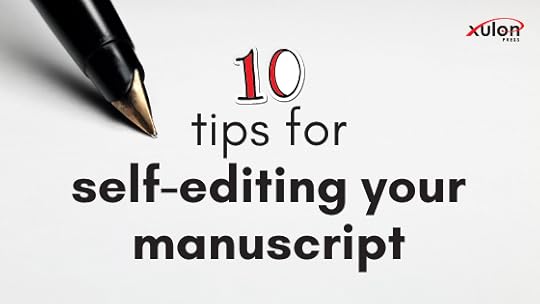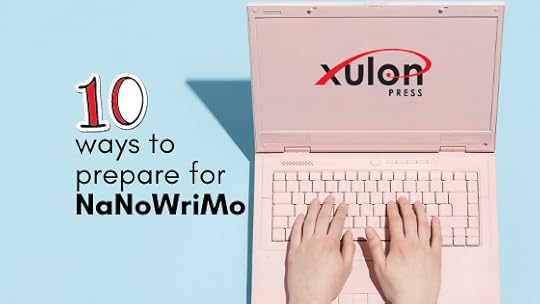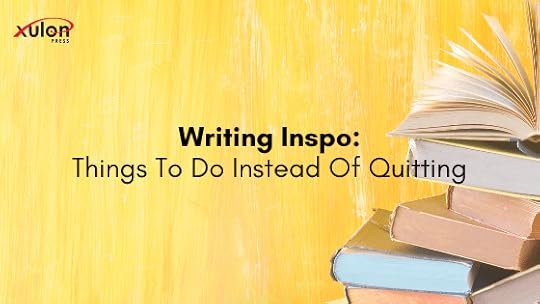Peter Lopez Jr.'s Blog: Xulon Press Blog , page 19
November 10, 2020
When to Use a Scene Break

Did you know the symbol—most commonly three asterisks—inserted between sections of text to break the scene is called a dinkus? Scene breaks serve many purposes, but one reason it’s used is to give readers a breather. Imagine reading an intense scene that holds a lot of significance, but the chapter doesn’t end when the scene ends. You’d need a little breather, right? That’s what the dinkus—or scene break—provides. Here are four other times to use a scene break.
1. When you want to transition from a present-day narrative to a flashback.
A scene break is a useful writing tool when you need to jump from present-day narrative to a flashback and then back to present-day. Readers may not mentally process the time jumps, but when they see the scene break symbol it’ll click that the scene is about to change.
2. When you want to transition to a new setting.
If one scene ends with your protagonist walking into class and the next scene picks up with him out with friends, use the scene break to mark the change in settings.
3. When you want to transition to backstory.
There will be times when you need to add some backstory to fill in plot holes for readers and the best way to make the transition from the current narrative to backstory is by using a scene break. This shows readers that the protagonist’s storyline is hopping back in time.
4. For emphasizing important moments.
Did one of your characters just say something profound and you want to give it all the attention it deserves before hopping back into the story? Use a scene break to force readers’ attention back to the last piece of dialogue before they move on in the story.
Feeling inspired to write? It isn’t too late to join NaNoWriMo 2020!
The post When to Use a Scene Break appeared first on Xulon Press Blog, Christian Self-Publishing.
November 5, 2020
How to Write a Flashback Scene

One of the best ways to work in a backstory for a character is through a powerful flashback, but getting a flashback right requires a little more time and attention than you might think. First, know why you’re thinking about including a flashback scene in your novel. Flashbacks should be used to show crucial moments that led to a character’s present decisions and way of thinking. For characters’ memories or large jumps in time, use a flashback scene.
Here are 5 tips to successfully add a flashback scene to your writing.
1. Do a quick outline.
Writing a scene in your novel that’s happened before the present moment can make keeping track of the timeframe, characters involved, differences in appearance, and a change in setting hard to keep track of.
2. Decide how to work it in.
Avoid dedicating extra words to a long, introductory paragraph before your flashback. Instead, dive right into it at the beginning of a chapter or scene.
3. Only focus on one event/experience.
Flashback scenes shouldn’t be too long and drawn out or cover a person’s entire backstory. For the scene to be strong, it must focus on just one moment or life event for the character. If you try to put too much into a flashback, your reader will lose track of where the present-day story is once you do finally get back to it.
4. Help move your overall story forward.
Flashbacks are only beneficial and useful to your characters—and your readers—if they help move your plot forward in some way. If it doesn’t serve a purpose, you’ll need to leave it behind.
5. Extra attention is needed for consistent verb tense.
You have a few options when it comes to verb tense in your flashback scene. You can write it in a different tense than your present-time story. If your present-day narrative is written in the past tense, you can use the present tense for your flashback scene. Or, you can keep the verb tense consistent throughout your entire novel. If you use past tense in your present-day narrative, continue that same tense in your flashback; you may, however, want to distinguish a difference in time periods by inserting the year somewhere into your flashback scene. For example, if your present-day novel is set in 2020, but your flashback scene jumps back to 1993, then mention 1993 somewhere at the beginning of your scene.
When it comes to flashback scenes, take time to decide if your novel actually needs it or not. Ask yourself: Do my readers benefit from seeing an earlier scene?
For more writing advice, visit our Ask The Editor section.
The post How to Write a Flashback Scene appeared first on Xulon Press Blog, Christian Self-Publishing.
October 29, 2020
How to Develop Your Characters

When it comes to developing characters, first-time writers often fall into two camps. The first camp doesn’t focus on creating character profile sheets and instead just wings it during their writing. The second camp thinks that a character should be as close to perfect humans as the writer can get them. Both of these can lead to very flat—somewhat boring—characters because they lack depth.
The secret to developing a character that is strong, well-rounded, interesting is grittiness. Every single character needs some negative traits, some traits that make them stand out from others, and traits that make them feel human.
Don’t shy away from the negative elements of your characters. None of us are perfect and the characters in books shouldn’t be either.
5 Things to Know About Your Characters
What is this character’s speaking style? Do they speak fast or slow? Are they monotone or enthusiastic when speaking? Do they have an accent or speak in a specific dialect?
Determine some defining gestures or movements for this character.
What are some unique physical attributes you should note about this character?
What is this character’s temperament? Are they easy-going or rigid?
What are the negative traits of this character?
It’s important to know basic information about each of your characters, like name, age, height, physical appearance, and where they live. But it’s the good and bad personality traits that really help bring your characters to life.
Want more writing tips? Visit our full list of writing tips for help at any stage of the writing process.
The post How to Develop Your Characters appeared first on Xulon Press Blog, Christian Self-Publishing.
October 27, 2020
How To Self-Edit Your Manuscript

A common thought among first-time writers is that once they finish writing their book it’s ready to go straight to a professional editor. However, there are two crucial steps that need to take place before you ship your manuscript off for editing. The first is that you must do a few rounds of self-editing yourself. This is the time to read your book as if you’ve never seen it before. Look for plot issues and other trouble spots that could trip your readers up. Take the time to delete material that doesn’t need to stay, run spell check, look for ways to simplify your language, and more. The other crucial step is beta reading, which you can read more about here. As for now, let’s jump into the top 10 tips for doing self-edits on your manuscript.
1. Avoid throat-clearing.
If you spend the first few pages of your book or a specific chapter giving backstory and setting the scene, that material needs to go. You need to be ruthless with your writing and cut these pages out. You can take that information and find better ways to work scene-setting and backstory through a more active storytelling approach. Instead, use your characters to do this work for you in dialogue, or use flashbacks.
2. Lean toward normal language over the complicated language.
Your book is not the place to show off your vocabulary. Your book’s reading level needs to meet a specific reading level for the genre you’re writing. There are plenty of tools online to check the reading level of your work, too. The Flesch-Kincaid score is commonly used.
3. Delete redundancy.
“She cried as tears ran down her cheeks.” This sentence can end after “cried” because “as tears ran down her cheeks” is redundant. Readers know she has tears because they have already been told she’s crying. The same goes for “Shawn blinked his eyes.” Delete “his eyes.” Comb through your work for these redundancies and delete the extraneous words.
4. The word “that” isn’t as necessary as you think.
In most cases, you can delete “that” anywhere you see it. You only need to keep it if the sentence is unclear without it.
5. Respect your readers.
Once you’ve told your readers something, you don’t need to repeat it. Remove additional word count you added to explain something readers will already understand.
6. Check your plot.
Ask yourself if your plot structure is engaging and logically flows throughout the story and maintains a certain level of momentum. If you have plot twists, do they make sense? (Beta readers are extremely important truth-tellers when it comes to plot issues.) Ask yourself if you’ve tied up all loose ends by the end of the book. If you haven’t, you need to go back through and connect all your dots. You also need to check your plot against traditional plot formulas used in your genre. If you don’t match up to what is currently selling, you’ll need to do some reworking.
7. Strong characters are important.
If you notice your characters coming off a little flat—not well rounded or not multidimensional—then you’ll need to take some time to refocus on your character profiles and incorporate new information to add depth to them in your story.
8. Scenes are required.
You can’t rely on backstory, scene-setting, and dialogue to tell a story. You must break your book into scenes that only move your story and your characters forward. If the material doesn’t progress the story, it’s important to leave it on the cutting-room floor.
9. Check your dialogue.
Each character needs to have her or his own tone and style of speaking. And if you start a character with a specific dialect, for continuity purposes you must continue that dialect throughout your manuscript for that character. Also, be sure you’re only using “said” or, “says” (depending on verb tense you’re writing in) for dialogue tags. Tags like “he huffed” or “she smiled” or “he laughed” aren’t correct dialogue tags.
10. Review your point of view.
If you start your story by using your protagonist to tell the story in the first person, you must continue that point of view throughout. That means you can’t switch and have a secondary character tell the story or share his or her thoughts. Everything has to come from the protagonist or be told to the protagonist.
Once you’ve self-edited your manuscript—which should take a few passes—you’ll want to engage some beta readers for your work. From there, you’ll want to take your beta readers’ thoughts to further revise your work before moving into a professional edit.
Tell us: Do you enjoy the writing process or the self-editing process more?
The post How To Self-Edit Your Manuscript appeared first on Xulon Press Blog, Christian Self-Publishing.
October 22, 2020
Body Language Cheat Sheet for Writers

A lot of first-time writers skip over portraying body language in their writing. They know it’s missing from their characters’ interactions, but they also aren’t sure how to include it either. To combat this, they try to mistakenly incorporate it into dialogue tags, such as “she smiled” or “he laughed.” But, if you think about it, we can’t smile words, and body language is about a lot more than smiling or laughing. The same experiences we walk through as humans—sadness, depression, jealousy, resentment—should all find their way into books.
Why Is Body Language Important?
Body language is important in writing because it not only adds another layer of depth to your characters—and your writing—but it also provides another level for readers to connect with your characters.
For instance, I have always been a hair-twirler. I do it without even realizing it. So, if I stumble upon a character who absentmindedly twirls her hair while she stares out a car window, I’m more likely to connect with that character.
How to Write Body Language In Your Writing
Understand what emotion or physical experience your character is going through, think about how a person in real life would react, both verbally and nonverbally (body language), and put it on paper. Here’s a cheat sheet for some common emotions and situations your characters might find themselves in:
If your character is angry:
She clenches her fists, slams a fist on a table or counter, crosses arms
If your character is anxious:
She holds her breath, twirls her hair, chews on a pen cap, has a posture
If your character is bored:
She yawns, rolls her eyes, struggles to keep her eyes open, taps foot on the floor, scribbles on a piece of paper
If your character is tired/fatigued/jet-lagged:
She stretches tight muscles, stares off, rubs her eyes, slow to respond, sips coffee, she takes a deep breath, and exhales
If your character is jealous:
She crosses her arms, she stares at the person she’s jealous of, she ignores the person she’s jealous of
If your character is sad:
Her lip quivers, her body shakes as she cries, she withdraws from people socially, she wraps her arms around herself, she collapses on the floor in tears
If your character is shy:
Her cheeks blush, she doesn’t make eye contact, she stands along a wall of a party by herself, she speaks in an almost whisper when introducing herself to someone
If you’re struggling to incorporate body language into your writing, go sit somewhere and people watch for a bit. Look for a couple in love and jot down notes about their body language toward each other. Spot someone who might be having a stressful moment of their day and pay attention to how they act and interact with others.
Looking for more writing tips? Visit our Ask the Editor section.
The post Body Language Cheat Sheet for Writers appeared first on Xulon Press Blog, Christian Self-Publishing.
October 13, 2020
10 Ways to Prepare for NaNoWriMo

We’re a few weeks out from the biggest novel writing challenge of the year: National Novel Writing Month! Every November, writers from around the world dedicate themselves to cranking out a 50,000-word first draft manuscript in 30 days. Tons of writers have gone on to publish their books after the challenge, and thousands have credited the process to help them finish a writing project that’s been sitting on their hearts for years.
If this is the year you’ve decided to write your novel, you still have plenty of time to finish the first draft before the end of the year, and joining NaNoWriMo can help.
Here are 10 ways you can get a jumpstart on NanWriMo this month without padding your word count ahead of time.
1. Create an account at NaNoWriMo.org
All you have to do is create a username and password, and confirm your email address to sign up.
2. Set up your profile and join your region.
Next, you’ll want to add a photo of yourself to your profile, add a short, interesting bio about yourself, and join the dedicated group for the region you live in. NaNoWriMo has always been a virtually based experience, so not much has changed with the pandemic except for the fact that there will be no group write-ins around your city.
3. Leave an introduction post about yourself on the thread for your region.
Once you join the group for your region, make sure to add a post to your region’s thread to introduce yourself and make some fast writing friends. You’ll want all the support you can get during the month of November.
4. Review the Nano Prep section of the NaNoWriMo website.
This is a great addition over the last few years because it helps participants get a lot of the prework out of the way before the writing clock begins. Take some time this month to review this section.
5. Start the Nano Prep 101 course.
The prep course is technically six weeks long, and while there aren’t six weeks until November you still have plenty of time to work through the weekly breakdowns to set yourself up for success.
6. Add virtual writing sessions you’ll want to participate in your calendar.
Review the NaNoWriMo calendar and see if there are any virtual sessions you want to attend in the month of October. These are great practice runs for virtual events during November.
7. Write your novel premise.
A premise is the elevator pitch for your book, and it’s what you’d deliver to a potential agent or editor who may be interested in your book in the future. The premise must be short but succinct and must be attention-grabbing. Your premise also helps keep you on task during the novel-writing process because you don’t want to navigate your writing away from it.
8. Focus on character development.
It’s important to have well-developed characters and that takes time. Create character profiles for each of your characters so you can begin to understand their personalities, temperaments, likes and dislikes, and their motivations. Doing this work helps you avoid flat characters in your writing.
9. Get some preliminary research out of the way.
If you’re writing historical fiction, science fiction, or are heavily relying on a real location for your novel, then you need to do as much research and note-taking as possible.
For historical fiction, you’ll not only want to research a specific town during that time period to model your novel’s location after, but you’ll also need to research popular word choices for that time period, medical advancements, and technology—or lack of—to ensure that your book will be as historically accurate as you can possibly get it. There’s nothing worse than reading a novel set in the 1800s and seeing the phrase, “what’s up?”
10. Decide where you’ll get the time to write 1,667 words a day for 30 days.
Hitting 1,667 words every day for 30 days may not sound like a lot but also sound unachievable at the same time. Keep in mind that even at the slowest pace, a writer should be able to get 500 words on paper in an hour. So, if you stay on task for two hours (or less) every day, you can easily hit 50,000 words in 30 days. Also keep in mind that if you know you have specific days during the month that you will not be able to write at all, you will want to plan ahead and add that day’s word count to a few other days to spread out the work.
Then, come November 1st, you’ll be on a well-organized path to writing success because you won’t lose time to outline your story, develop characters, or do surface-level research. You can dive straight into writing on day one of the challenges.
Check out our other NaNoWriMo articles for more inspiration.
The post 10 Ways to Prepare for NaNoWriMo appeared first on Xulon Press Blog, Christian Self-Publishing.
October 7, 2020
Top 5 Free eBook Readers

When you purchase any of our ebooks you’ll notice you receive the download link as an EPUB or MOBI file. If you’re new to ebooks you may not familiar with these. And if you’re wondering how to open these files to view your book, we’ve got you covered. Check out this list of the best-rated, free ebook readers:
1. Calibre
Calibre is an easy to use open-source e-book manager and reader. It allows you to read e-books in all the major ebook formats including MOBI and EPUB files.
2. Adobe Digital Editions
Adobe Digital Editions is an easy to use eReader. The tool also allows you to download and purchase digital content and can read e-books in multiple file formats, including EPUB, EPUB3, and PDF.
3. Librera Reader
Librera Reader (Lirbi Reader, PDF Reader) is a customizable and feature-rich application. It allows you to read e-books in PDF, EPUB, MOBI, DjVu, FB2, TXT, RTF, AZW, AZW3, HTML, CBZ, CBR formats.
4. iBooks for Apple
Apple Books (iBooks) is an ebook reading and store application by Apple for its iOS and macOS operating systems and devices. This app should already be installed on your Mac and iPhone and is a quick and free download from the app store if it isn’t. This app will allow you to open our EPUB files.
5. Sony Reader for PC
Sony Reader for PC is a freeware software app filed under eBooks software and made available by Sony for Windows. This reader allows you to access various types of eBooks, Newspapers, and Magazines from Reader Store on your Windows 7, 8, and 10. This tool will allow you to open our EPUB files.
The post Top 5 Free eBook Readers appeared first on Xulon Press Blog, Christian Self-Publishing.
October 1, 2020
Writing Inspo: Things To Do Instead Of Quitting

“The best way out is always through.” —Robert Frost
I think it’s safe to say we’ve all had moments when we want to give up on a writing project or quit writing altogether. If you’re in need of some writing inspo, or you’ve been thinking about quitting recently, here are other things you can try instead:
Consider your purpose for writing.
Why did you want to write in the first place? How does your writing help you? How does it change you? In what ways do you hope it will help or inspire others?
Consider your book’s purpose.
What were you trying to achieve with this book?
Rethink the structure.
Reading stories that have sold well can teach you how to tell a better story. Look at examples of books or stories in your genre that are doing well and take note of the structure. Is there anything you can borrow from it to make your project work even better?
Switch up the point of view.
Have you thought about starting over from another character’s point of view? Writing from another character’s point of view might help you find a way forward.
Write sideways instead of forward.
Instead of pushing yourself to write forward on your project, work on backstory, expand a setting or section of your book, or see if doing more research sparks inspo.
Practice writing with no purpose.
When was the last time you wrote just for fun? Involve writing in your everyday life, and not just to advance your next writing project. Keep a journal and don’t assign a purpose to it. Write ideas, notes, and questions about your story. Use it to list anything you’re curious about, what you’re grateful for, what makes you laugh, etc. Just write.
Start a new writing project.
Pause working on the current project that’s frustrating you and write something new. Diving into a new project can spark energy for writing again.
Take a real break.
Sometimes “I want to quit” is really “I’m so tired.” What you need is a break. But watching Netflix and scrolling on social media won’t help—it’ll actually just end up making you feel more tired. What makes you feel refreshed? Try walking in nature, listening to music, cooking with a new recipe, making/viewing art, etc.
Ask for help.
A critique group or editor could help figure out how to solve your book’s problems. Consider our professional editing services for help on your next manuscript.
Have any tips of your own? Comment them below!
The post Writing Inspo: Things To Do Instead Of Quitting appeared first on Xulon Press Blog, Christian Self-Publishing.
September 29, 2020
Writing a Lot Versus Writing Well

I think back to some college literature courses I took, and the required length of papers I had to turn in. It wasn’t uncommon to have to produce an eight-page essay, but hitting that page count was hard every single time. I found myself using filler words, expanding my sentences to take up more space. I traded direct and pointed sentences for ones that were way too long and wordy—and sometimes a little redundant.
I think that focus to get as many words on paper sticks with us as writers, but it shouldn’t. In fact, when writing a book, the goal should be to write as clean, compact, and direct as we can. The goal is actually to use fewer words to make a point, not more words.
There are two approaches to writing: write a lot and write well. These two don’t mean the same thing, and a writer can’t produce quality writing without employing both approaches at different points in the writing process. Let’s jump into these two approaches:
Write a Lot
There are two times to employ the “write a lot” approach in your writing. The first is when you are getting comfortable with writing as a whole. Take time to write a lot of short stories, essays, poems, character descriptions, summaries of your story, and more. Writing has a lot to do with training, so the more you train yourself to be comfortable and confident writing, the easier writing a longer project will be.
The second time to employ the “write a lot” approach in your work is when you are creating the first draft of a manuscript. It’s critical to get as many thoughts and words on paper as you can. If you write a fiction novel that is supposed to be 100,000 words at the final stage of writing, your first draft is going to have to be over that word count in preparation for the revision process.
While writing your first draft, your focus can’t be on editing your work. Staying in the writing mindset, and ignoring revising and tweaking sentences, is the only way you’re going to finish your draft. So, write a lot and edit nothing.
Write Well
If you don’t edit a single word while writing your first draft, when you go back to start revising your work, you’re going to see just how messy writing is—and that’s okay. Writing the first draft is supposed to be messy. It’s what you do with that mess that counts.
More often than not, I get first drafts from writers to edit for them. I know it’s their first draft because I see all the items the writer would have caught if they had read their work through at least once.
The writer’s revision process is just as important as the initial writing process. It is when you must employ the “write well” approach.
During revisions, your only goal is to make your manuscript better and easier to read. This means revising run-on sentences into shorter, more direct sentences. It means paying attention to word choice and simplifying your language. It means looking for filler words and deleting them from your work. It means hunting down adverbs (words that end in -ly) and deleting them so you can use strong verbs instead. It means finding your own plot holes and filling them in. When you focus on your revision process, your word count should decrease. That’s why it’s important to write over your word count goal during the “write a lot” stage.
Writing takes a formula of approaches that need to be used at specific points in your process. You won’t become a good writer just by writing a lot; you also need to focus on writing well.
Tell us, where are you in your writing journey?
Our article library is full of writing and publishing advice to help you no matter where you are in the process.
The post Writing a Lot Versus Writing Well appeared first on Xulon Press Blog, Christian Self-Publishing.
September 24, 2020
Why Every Author Needs An Audiobook

Did you know more than half of all Americans listened to an audiobook in 2019? You might be asking yourself, why is this new book format so popular? Why is it trending at a faster pace than ebooks and traditional books?
When you ask consumers, convenience seems to be the main reason for choosing audiobooks over reading. I mean think about it, you can now listen to a book anywhere while doing almost anything. In this fast-paced world where multi-tasking is everything, it’s not hard to see why audiobooks are growing in popularity.
With all that said, it’s no doubt that audiobooks are the hot and trendy book format currently, but should you consider publishing an audiobook as an indie (self-published) author? Are they worth the effort and costs involved? We’ve highlighted some key benefits to help you decide if an audiobook is right for you.
1. A promising market.
Already valued at billions, the global audiobook market is predicted to grow by 25% this year alone–considering the media and entertainment growth standard is just 4%, a 25% increase in growth is impressive, to say the least.
2. Reach a new audience.
This modern and powerful book format is the ideal tool for expanding your reach and getting your book in the hands (or more accurately, the ears!) of a new and very large audience. By expanding your reach into the audiobook market, you’ll be exposing your book to a whole new range of readers who might have never discovered you otherwise.
3. Less competition.
Currently, the audiobook market is notably less saturated than the physical and ebook markets. This gives indie authors a significantly higher chance of being discovered by some fresh eyes.
4. Increase your potential revenue.
Having another source of revenue as an indie author–or in general–is always a good thing. Not only are you increasing your revenue options with audiobooks, but you’re also diversifying them. Much like any freelancer needs a range of clients to balance out their income, indie authors should have diverse income streams to fill in any potential gaps.
5. Gain credibility.
These days pretty much anyone can create and publish an ebook, but the same can’t be said for audiobooks. As you can see from #3, creating an audiobook won’t be undertaken by every author, so the ones who do will certainly stand out.
Interested in publishing an audiobook? Give us a call at 1-866-381-2665 or check us out at XulonPress.com
The post Why Every Author Needs An Audiobook appeared first on Xulon Press Blog, Christian Self-Publishing.
Xulon Press Blog
- Peter Lopez Jr.'s profile
- 8 followers



